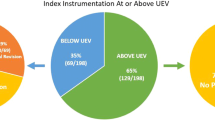Abstract
Study Design
Comparative cohort study.
Objective
To compare coronal deformity control, lengthening efficacy, and sagittal alignment between distraction-based growing rod constructs utilizing tandem versus wedding band connectors.
Summary of Background Data
Different construct designs exist for growing rod treatment of early-onset scoliosis. All use a version of a rod connector, with the two main types being tandem and wedding band. Little data exist to quantify the impact of connector choice on radiographic outcomes of treatment.
Methods
A multicenter database of prospectively and retrospectively collected data on early-onset scoliosis patients was reviewed. Patients of any thoracic or thoracolumbar coronal plane deformity whose initial growing rod treatment was initiated before age 10 years and underwent at least 3 years of dual growing rod treatment with either tandem or wedding band connectors were included. Preoperative, immediate postoperative, and prefinal radiographs were reviewed and compared in regard to major curve magnitude, T1–T12 and T1–S1 spinal length, length of instrumentation, and sagittal plane measures.
Results
A total of 209 patients were included. The overall percent change from preoperative to prefinal in all radiographic parameters was not different between the two groups indicating similar efficacy in treatment. After controlling for institutional variation, the improvement of the major coronal Cobb angle from preoperative to prefinal was statistically improved for the tandem group (34° vs. 29°, p = .002) and the difference in T5–T12 kyphosis from preoperative to prefinal was significantly different between the groups (−6° vs. +1.3°, p = .008).
Conclusion
We identified little difference in the effects of connector type on radiographic outcomes of patients treated with traditional growing rod, which indicates that both wedding band and tandem connectors function similarly. The small differences detected suggest that tandem connectors may improve major Cobb correction, and wedding band connectors may maintain thoracic kyphosis over time.
Level of Evidence
Level III
Similar content being viewed by others
References
Yang JS, McElroy MJ, Akbarnia BA, et al. Growing rods for spinal deformity: characterizing consensus and variation in current use. J Pediatr Orthop 2010;30:264–70.
Bess S, Akbarnia BA, Thompson GH, et al. Complications of growing-rod treatment for early-onset scoliosis: analysis of one hundred and forty patients. J Bone Joint Surg Am 2010;92:2533–43.
Akbarnia BA, Marks DS, Boachie-Adjei O, et al. Dual growing rod technique for the treatment of progressive early-onset scoliosis: a multicenter study. Spine (Phila Pa 1976) 2005;30(17 suppl):S46–57.
Yang JS, Sponseller PD, Thompson GH, et al. Growing rod fractures: risk factors and opportunities for prevention. Spine (Phila Pa 1976) 2011;36:1639–44.
Vitale MG, Gomez JA, Matsumoto H, Roye Jr DP. Variability of expert opinion in treatment of early-onset scoliosis. Clin Orthop Relat Res 2011;469:1317–22.
Schroerlucke SR, Akbarnia BA, Pawelek JB, et al. How does thoracic kyphosis affect patient outcomes in growing rod surgery? Spine (Phila Pa 1976) 2012;37:1303–9.
Author information
Authors and Affiliations
Consortia
Corresponding author
Additional information
Author disclosures: MEO (personal fees from Children’s National Medical Center, grants from Pediatric Orthopaedic Society of America, grants from Children’s National Medical Center Board of Visitors, grants from Joseph E Robert, Jr. Endowment for Surgical Care, grants from Orthopaedic Research and Education Foundation/Regents of the University of Minnesota, grants from CareFusion Foundation, outside the submitted work), AM (personal fees from Children’s National Medical Center, outside the submitted work), YW (none), LB (personal fees from K2M Medical, during the conduct of the study; other from Spine Deformity Journal, outside the submitted work), JP (none), AM (none), PS (personal fees from JBJS, grants and personal fees from DePuy, personal fees from Oakstone Medical Publisher, from Globus, during the conduct of the study), FSP-G (grants from DePuy Synthes, personal fees from K2M, outside the submitted work), BA (grants and personal fees from NuVasive, personal fees from K2M, personal fees from DePuy Spine, personal fees from NociMed, outside the submitted work), Growing Spine Study Group (grants from Growing Spine Foundation, during the conduct of the study; grants from NuVasive, outside the submitted work).
Funding statement: The Growing Spine Foundation financially supports the Growing Spine Study Group, the multi-center study group that provided the data for this research study. The Growing Spine Foundation receives funding support from its surgeon members, patients, other donors, and the medical device industry.
Rights and permissions
About this article
Cite this article
Oetgen, M.E., Matthews, A., Wang, Y. et al. Radiographic Outcome Differences in Distraction-Based Growing Rod Constructs Using Tandem Versus Wedding Band Connectors. Spine Deform 6, 314–319 (2018). https://doi.org/10.1016/j.jspd.2017.10.014
Received:
Accepted:
Published:
Issue Date:
DOI: https://doi.org/10.1016/j.jspd.2017.10.014



